Jan Marco Leimeister
Generative AI for Banks: Benchmarks and Algorithms for Synthetic Financial Transaction Data
Dec 19, 2024Abstract:The banking sector faces challenges in using deep learning due to data sensitivity and regulatory constraints, but generative AI may offer a solution. Thus, this study identifies effective algorithms for generating synthetic financial transaction data and evaluates five leading models - Conditional Tabular Generative Adversarial Networks (CTGAN), DoppelGANger (DGAN), Wasserstein GAN, Financial Diffusion (FinDiff), and Tabular Variational AutoEncoders (TVAE) - across five criteria: fidelity, synthesis quality, efficiency, privacy, and graph structure. While none of the algorithms is able to replicate the real data's graph structure, each excels in specific areas: DGAN is ideal for privacy-sensitive tasks, FinDiff and TVAE excel in data replication and augmentation, and CTGAN achieves a balance across all five criteria, making it suitable for general applications with moderate privacy concerns. As a result, our findings offer valuable insights for choosing the most suitable algorithm.
Supporting Cognitive and Emotional Empathic Writing of Students
May 31, 2021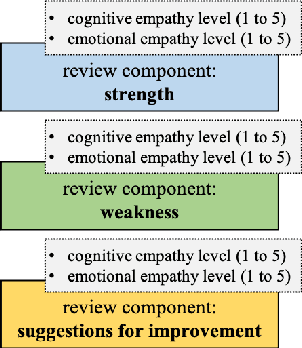
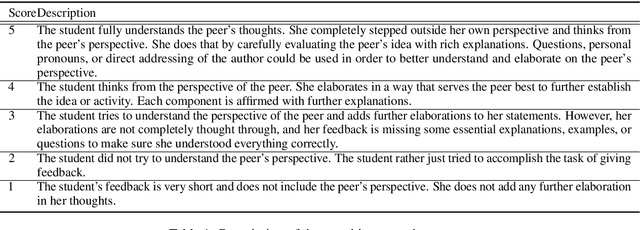
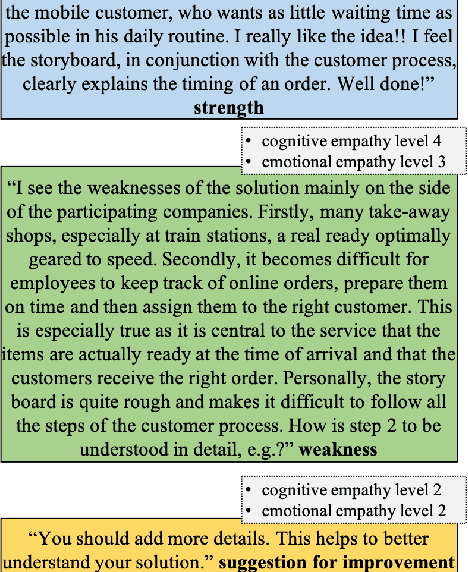

Abstract:We present an annotation approach to capturing emotional and cognitive empathy in student-written peer reviews on business models in German. We propose an annotation scheme that allows us to model emotional and cognitive empathy scores based on three types of review components. Also, we conducted an annotation study with three annotators based on 92 student essays to evaluate our annotation scheme. The obtained inter-rater agreement of {\alpha}=0.79 for the components and the multi-{\pi}=0.41 for the empathy scores indicate that the proposed annotation scheme successfully guides annotators to a substantial to moderate agreement. Moreover, we trained predictive models to detect the annotated empathy structures and embedded them in an adaptive writing support system for students to receive individual empathy feedback independent of an instructor, time, and location. We evaluated our tool in a peer learning exercise with 58 students and found promising results for perceived empathy skill learning, perceived feedback accuracy, and intention to use. Finally, we present our freely available corpus of 500 empathy-annotated, student-written peer reviews on business models and our annotation guidelines to encourage future research on the design and development of empathy support systems.
Finding the unicorn: Predicting early stage startup success through a hybrid intelligence method
May 07, 2021Abstract:Artificial intelligence is an emerging topic and will soon be able to perform decisions better than humans. In more complex and creative contexts such as innovation, however, the question remains whether machines are superior to humans. Machines fail in two kinds of situations: processing and interpreting soft information (information that cannot be quantified) and making predictions in unknowable risk situations of extreme uncertainty. In such situations, the machine does not have representative information for a certain outcome. Thereby, humans are still the gold standard for assessing soft signals and make use of intuition. To predict the success of startups, we, thus, combine the complementary capabilities of humans and machines in a Hybrid Intelligence method. To reach our aim, we follow a design science research approach to develop a Hybrid Intelligence method that combines the strength of both machine and collective intelligence to demonstrate its utility for predictions under extreme uncertainty.
Design principles for a hybrid intelligence decision support system for business model validation
May 07, 2021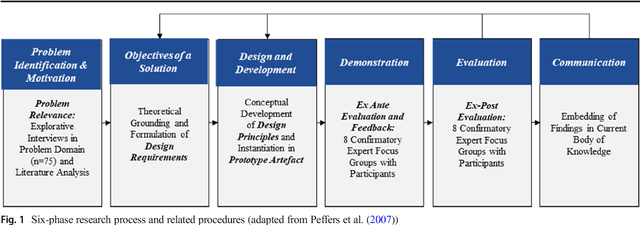
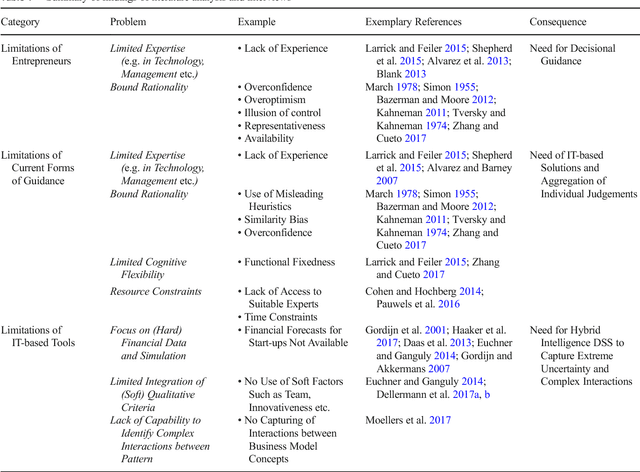

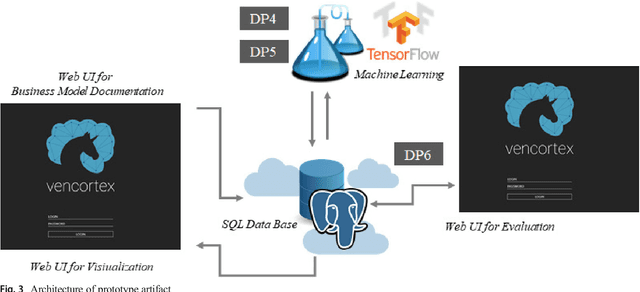
Abstract:One of the most critical tasks for startups is to validate their business model. Therefore, entrepreneurs try to collect information such as feedback from other actors to assess the validity of their assumptions and make decisions. However, previous work on decisional guidance for business model validation provides no solution for the highly uncertain and complex context of earlystage startups. The purpose of this paper is, thus, to develop design principles for a Hybrid Intelligence decision support system (HI-DSS) that combines the complementary capabilities of human and machine intelligence. We follow a design science research approach to design a prototype artifact and a set of design principles. Our study provides prescriptive knowledge for HI-DSS and contributes to previous work on decision support for business models, the applications of complementary strengths of humans and machines for making decisions, and support systems for extremely uncertain decision-making problems.
Hybrid Intelligence
May 03, 2021


Abstract:Research has a long history of discussing what is superior in predicting certain outcomes: statistical methods or the human brain. This debate has repeatedly been sparked off by the remarkable technological advances in the field of artificial intelligence (AI), such as solving tasks like object and speech recognition, achieving significant improvements in accuracy through deep-learning algorithms (Goodfellow et al. 2016), or combining various methods of computational intelligence, such as fuzzy logic, genetic algorithms, and case-based reasoning (Medsker 2012). One of the implicit promises that underlie these advancements is that machines will 1 day be capable of performing complex tasks or may even supersede humans in performing these tasks. This triggers new heated debates of when machines will ultimately replace humans (McAfee and Brynjolfsson 2017). While previous research has proved that AI performs well in some clearly defined tasks such as playing chess, playing Go or identifying objects on images, it is doubted that the development of an artificial general intelligence (AGI) which is able to solve multiple tasks at the same time can be achieved in the near future (e.g., Russell and Norvig 2016). Moreover, the use of AI to solve complex business problems in organizational contexts occurs scarcely, and applications for AI that solve complex problems remain mainly in laboratory settings instead of being implemented in practice. Since the road to AGI is still a long one, we argue that the most likely paradigm for the division of labor between humans and machines in the next decades is Hybrid Intelligence. This concept aims at using the complementary strengths of human intelligence and AI, so that they can perform better than each of the two could separately (e.g., Kamar 2016).
A Corpus for Argumentative Writing Support in German
Oct 26, 2020



Abstract:In this paper, we present a novel annotation approach to capture claims and premises of arguments and their relations in student-written persuasive peer reviews on business models in German language. We propose an annotation scheme based on annotation guidelines that allows to model claims and premises as well as support and attack relations for capturing the structure of argumentative discourse in student-written peer reviews. We conduct an annotation study with three annotators on 50 persuasive essays to evaluate our annotation scheme. The obtained inter-rater agreement of $\alpha=0.57$ for argument components and $\alpha=0.49$ for argumentative relations indicates that the proposed annotation scheme successfully guides annotators to moderate agreement. Finally, we present our freely available corpus of 1,000 persuasive student-written peer reviews on business models and our annotation guidelines to encourage future research on the design and development of argumentative writing support systems for students.
Collaborative Interactive Learning -- A clarification of terms and a differentiation from other research fields
May 16, 2019Abstract:The field of collaborative interactive learning (CIL) aims at developing and investigating the technological foundations for a new generation of smart systems that support humans in their everyday life. While the concept of CIL has already been carved out in detail (including the fields of dedicated CIL and opportunistic CIL) and many research objectives have been stated, there is still the need to clarify some terms such as information, knowledge, and experience in the context of CIL and to differentiate CIL from recent and ongoing research in related fields such as active learning, collaborative learning, and others. Both aspects are addressed in this paper.
 Add to Chrome
Add to Chrome Add to Firefox
Add to Firefox Add to Edge
Add to Edge